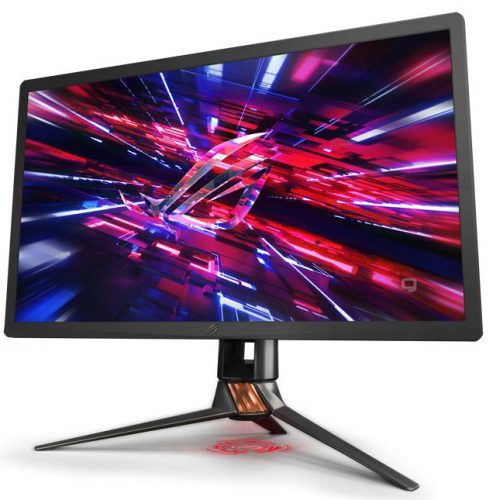Asus ROG Swift PG27UQX with 4K, 144Hz Refresh and 576-zone Mini LED Backlight

At this year’s Computex event in Taiwan NVIDIA and Asus announced the forthcoming ROG Swift PG27UQX display, the successor to the very high end PG27UQ we reviewed last year. That was one of the first displays with a 4K resolution and 144Hz refresh rate combined and was available in 27″ size. It also featured NVIDIA G-sync and a 384-zone FALD backlight for VESA DisplayHDR 1000 support. The new PG27UQX model will update that screen and will make use of a 576-zone Mini LED backlight unit instead. More zones make it possible to illuminate smaller objects without bright light bleeding all over dark scenes. Since that’s one of the main critiques leveled against today’s best displays capable of full-array local dimming, the PG27UQX represents a big step forward in bettering the LED LCD category as a whole.
Mini LED backlight
The Asus press release talks about the use of Mini LED in more detail:
“Imagine the existing PG27UQ’s 4K panel as a checkerboard made up of 384 squares lit by 384 LEDs. The LEDs in each of those zones can be controlled on a per-square basis to make them dim or bright, depending on the content you’re looking at. By varying their intensity, it’s possible to attain really high contrast ratios, creating big differences between the darkest blacks and brightest whites.
But when the LEDs in one square are fully illuminated and zones adjacent to it are dim, you end up with a noticeable halo or bloom effect. It’s an artifact inherent to LED LCDs with localized backlights. Dividing the panel into more zones, however, helps diminish the effect since each zone is smaller, with fewer LEDs generating superfluous backlighting.
Rather than using conventional LEDs, which are between 700 and 800 µm, our new ROG Swift PG27UQX employs much smaller Mini LEDs that are roughly 200 – 300 µm. It spans the same 27” but is divided into 576 zones, each of which uses four LEDs for a total of 2,304 LEDs. The increase means bloom can be reduced by as much as 33% compared to our already-awesome PG27UQ. Mini LEDs also use less power than their predecessor. Consequently, the PG27UQX’s panel consumes 7% less power than the PG27UQ, translating to lower electricity bills and less heat to dissipate.”
Active Cooling Fan
Asus have also acknowledged some of the gripes with the active cooling fan found on the PG27UQ, and while a fan is sitll needed, they’ve taken measures to try and keep its noise to a minimum:
“The ROG Swift PG27UQX is packed with cutting-edge components like NVIDIA’s latest G-Sync Ultimate module, so it requires active cooling despite the Mini LEDs’ enhanced energy efficiency. To keep the high-tech hardware operating at a comfortable temperature, we borrowed some of the intelligence responsible for keeping our graphics cards running cool and quiet.
Smart fan control dials in the exact rotational speed needed to maintain ideal thermals without overdoing it and causing unnecessary noise. The platform’s two fans operate silently, generating barely more than a whisper.”
Other Specs and Features
Spec wise the screen is 27″ in size and uses an IPS-type panel. There is a 3840 x 2160 Ultra HD (“4K”) resolution, 144Hz maximum overclocked refresh rate and 178/178 viewing angles talked about in the information available so far. Expect also a 4ms G2G response time, 1000:1 contrast ratio and 1.07b colour depth like the PG27UQ. The screen uses the v2 NVIDIA G-sync hardware module to support variable refresh rates.
The HDR capabilities of its predecessor have been kept, with a DisplayHDR 1000 certification offering 1000 cd/m2 peak brightness. There is also a 99% Adobe RGB gamut, covering also 97% of the DCI-P3 colour space thanks to the use of Quantum Dot coating again. The screen is factory calibrated to offer a dE < 3 as well.
The ROG logo on the back sports RGB lighting and Aura Sync support allows you to tie the color and effects to other Aura Sync-compatible components. Another ROG logo built into the stand projects light onto the desk below, and the monitor comes bundled with a blank cover so you can design a custom logo to splash across your space.
Connectivity wise there are 1x DisplayPort 1.4, 1x HDMI 2.0 and 2x USB 3.0 ports offered along with a headphone jack. The stand should offer a full range of tilt, height, swivel and rotate adjustments.
Acer Predator alternative

While no real information is given in the NVIDIA press release, with a model name not even being mentioned, they do also reference an Acer Mini LED monitor coming soon which will presumably be very similar like their Predator X27 was to the PG27UQ last year. No real information on that yet.
No word on release dates or prices yet, but expect both to be very expensive!
Update: This Mini LED panel isn’t expected to go in to production until August, and won’t be available until around October 2019 according to current views. Don’t expect to see those new Asus or Acer screens until Q4 at the earliest. Further info in our news piece here.
News alerts and more – follow us on Twitter
Subscribe to our News RSS feed
